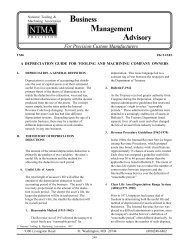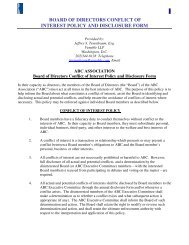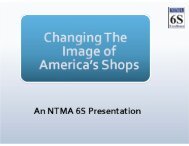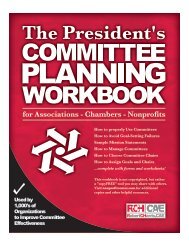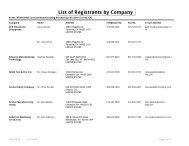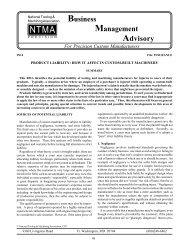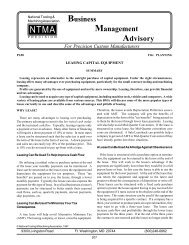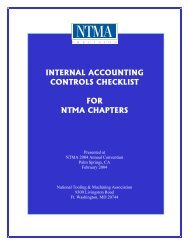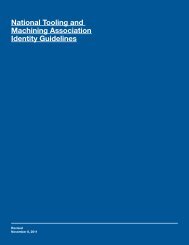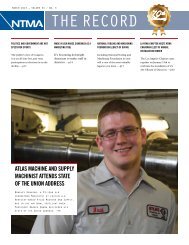Establishing A Quality System for Defense Work - National Tooling ...
Establishing A Quality System for Defense Work - National Tooling ...
Establishing A Quality System for Defense Work - National Tooling ...
You also want an ePaper? Increase the reach of your titles
YUMPU automatically turns print PDFs into web optimized ePapers that Google loves.
measures. Test reports, inspection records, certificates and<br />
other documents can be used to provide evidence of consistent<br />
quality.<br />
Your quality manual can meet these purchasing control<br />
requirements by stating your procedures and recordkeeping<br />
methods <strong>for</strong> controlling vendor per<strong>for</strong>mance. Using fully<br />
documented written purchase orders <strong>for</strong> all supplies will also<br />
help keep your requirements explicit and can help to avoid<br />
mistakes or disputes. It is particularly important to reference<br />
all government specs involved in purchase orders <strong>for</strong> subcontract<br />
work or supplies including drawings, engineering change<br />
orders, specifications, any special per<strong>for</strong>mance or safety<br />
requirements, unusual test requirements and so on.<br />
The longest section of MIL-Q-9858A deals with Manufacturing<br />
Control. Control of incoming materials is the first item<br />
covered, requiring provisions <strong>for</strong> receiving inspection. It<br />
specifies that outside test labs may be utilized when necessary.<br />
You must also require your subcontractors to use<br />
“equivalent controls” <strong>for</strong> material used in parts <strong>for</strong> your<br />
contract. Methods of identifying material and its inspection<br />
status must also be used. This is usually accomplished by a<br />
combination of tagging and marking. Whatever methods you<br />
choose should be specified in your manual.<br />
On the subject of production processing and fabricating,<br />
the specification requires you to assure that machining,<br />
assembly and other operations take place under “controlled<br />
conditions.” These controlled conditions primarily refer to<br />
written work instructions, as on job tickets or routing slips.<br />
Controlled conditions are also interpreted to include adequate<br />
equipment and there<strong>for</strong>e, your quality manual should<br />
also mention your machine maintenance program.<br />
Inspection and monitoring at each work operation are<br />
necessary, and inspection procedures and results should also<br />
be recorded. Furthermore, the criteria <strong>for</strong> acceptance and<br />
rejection and ways of identifying acceptable and rejected<br />
parts must be specified. The specification also notes that<br />
special exotic situations may also require additional documentation.<br />
These obligations must be detailed separately <strong>for</strong><br />
the requirements of each job, but developing a simple systematic<br />
method with control <strong>for</strong>ms that can be used routinely will<br />
greatly simplify this task.<br />
Your control <strong>for</strong>m should have space <strong>for</strong> written instructions <strong>for</strong><br />
machining and <strong>for</strong> inspection. It should specify the drawing number,<br />
contract or job number, material, machine to be used, tooling, setup<br />
in<strong>for</strong>mation, identification of appropriate NC tapes or programs and<br />
any other pertinent details. Space may be provided <strong>for</strong> a sketch on<br />
the <strong>for</strong>m itself or drawings may be attached.<br />
If your work usually involves quantity runs, a separate <strong>for</strong>m<br />
can be used <strong>for</strong> inspection results, identifying only the job<br />
number, batch date, work station, operation and results. If<br />
your work tends to be in small lots, this in<strong>for</strong>mation could be<br />
on the reverse side of the job ticket itself.<br />
The specification requires a system <strong>for</strong> final inspection and<br />
testing of completed products. The standard states that “Such<br />
testing shall be per<strong>for</strong>med so that is stimulates, to a sufficient<br />
degree, product end use and functioning” (emphasis added).<br />
Obviously, simulation of many defense products’ end use<br />
in a machine shop can be virtually impossible. If there is any<br />
question as to what constitutes “a sufficient degree,” get the<br />
answer in writing from your contract officer.<br />
Handling, storage and delivery of government work is also<br />
covered in the specification’s section on manufacturing controls.<br />
<strong>Work</strong> and inspection instructions must also cover<br />
handling, storage and shipping considerations. Special crates,<br />
boxes, wrappings, etc. must be used when parts require protection<br />
in handling.<br />
If parts are to be stored at your facilities, they must be<br />
periodically inspected <strong>for</strong> deterioration or damage. Any<br />
special storage or handling requirements must be noted on<br />
containers or in the storage areas. The quality program must<br />
also include provisions to assure compliance with ICC regulations<br />
on shipping and must monitor shippers’ protection of<br />
products in transit.<br />
The contractor is required to “establish and maintain” an<br />
effective and positive system <strong>for</strong> controlling noncon<strong>for</strong>ming<br />
material. Requirements include specifying procedures <strong>for</strong><br />
keeping such material segregated, getting clearance <strong>for</strong> rework<br />
and tracking costs associated with noncon<strong>for</strong>ming<br />
materials.<br />
The use of statistical quality control methods is permitted<br />
under MIL-Q-9858A even when the contract does not specifically<br />
require such techniques. The use of statistical methods<br />
is permitted whenever such procedures are appropriate to<br />
improve quality control. Effective use of statistical techniques<br />
can actually reduce your inspection requirements,<br />
saving time, labor and money. We’ll discuss statistical<br />
quality control at greater length elsewhere, but <strong>for</strong> right now,<br />
you can note that the government specs on statistical quality<br />
control most often used <strong>for</strong> tooling and machining work are<br />
MIL-STD-105, and to a lesser extent, MIL-STD-414, or<br />
Handbooks H-106, 107 and 108. If you elect to use some other<br />
statistical method you must obtain clearance from your<br />
contract officer.<br />
MIL-Q-9858A briefly states a requirement <strong>for</strong> maintaining<br />
a system of identifying the inspection status of products.<br />
Your controls can be whatever methods you choose to use, as<br />
long as they differ from the government’s own inspection<br />
identification.<br />
The final major section of the specification covers two main<br />
areas: government inspection at subcontractor or vendor<br />
facilities and government-furnished property. When the<br />
government requires inspections at your suppliers’ plants the<br />
following statement must be included in your purchase order to<br />
your vendors:<br />
“Government inspection is required prior to shipment from<br />
your plant. Upon receipt of this order, promptly notify the<br />
government representative who normally services your plant<br />
so that appropriate planning <strong>for</strong> government inspection can<br />
be accomplished.”<br />
The government may sometimes require that copies of the<br />
purchase order itself be furnished to the vendor’s government<br />
rep, and an additional purchase order statement is provided <strong>for</strong><br />
that case.<br />
A series of requirements <strong>for</strong> handling government-furnished<br />
materials is also provided, and these generally parallel<br />
the material control requirements elsewhere in the specification.<br />
As you can see, setting up a quality program and an<br />
effective quality manual is not something to be taken lightly.<br />
When done correctly, a good quality program will pay off by<br />
300





